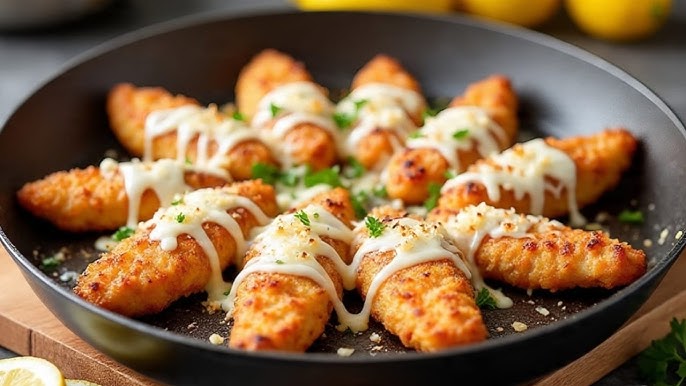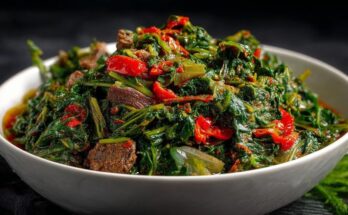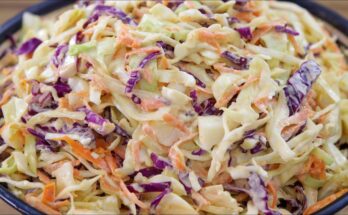Chicken Tenderloin Recipe: Chicken tenderloin is one of the most versatile and delicious cuts of chicken. Known for its soft, juicy texture and mild flavor, it’s a favorite among home cooks and chefs alike. Unlike chicken breast, which can sometimes turn out dry if not cooked properly, tenderloins are naturally more tender and forgiving. Whether you’re cooking for your family, meal prepping for the week, or hosting a dinner, this recipe will quickly become a go-to option.
Why Choose Chicken Tenderloin?
Chicken tenderloins cook quickly, absorb flavors easily, and can be prepared in countless ways—pan-fried, baked, grilled, or even air-fried. They’re lean, high in protein, and low in fat, making them a healthier choice compared to fried foods or red meat. Plus, their uniform size helps ensure even cooking, which is great for beginners.
The Popularity of Chicken Tenderloin in Everyday Cooking
In many households, chicken tenderloin is a staple ingredient because it fits seamlessly into a variety of cuisines. From Asian stir-fries and Italian pasta dishes to American comfort food and Mediterranean-inspired meals, this cut adapts beautifully. Because of its versatility and mild flavor, chicken tenderloin is perfect for picky eaters as well as adventurous foodies who love experimenting with spices.
Ingredients You’ll Need
Before diving into the cooking process, let’s gather everything required to make a mouthwatering chicken tenderloin dish.
Essential Ingredients for the Recipe
- 1 lb chicken tenderloins (about 8–10 pieces)
- 2 tablespoons olive oil (or melted butter)
- 2 teaspoons garlic powder
- 1 teaspoon onion powder
- 1 teaspoon paprika
- 1 teaspoon salt
- ½ teaspoon black pepper
- Juice of 1 lemon
Optional Add-ons and Seasoning Variations
To make your chicken even more flavorful, you can mix and match seasonings. Some popular add-ons include:
- Chili powder or cayenne pepper (for heat)
- Fresh herbs like rosemary, thyme, or parsley
- Soy sauce or Worcestershire sauce (for a deeper umami taste)
- Honey or brown sugar (for a touch of sweetness)
- Parmesan cheese (for a cheesy crust when baked)
Kitchen Tools You’ll Need
- Cutting board and sharp knife
- Mixing bowl for marinating
- Skillet or baking tray (depending on cooking method)
- Meat thermometer (to check doneness)
- Tongs or spatula
Preparing the Chicken Tenderloins
Preparation is key to ensuring your chicken turns out juicy, flavorful, and tender every time.
Cleaning and Trimming Chicken Tenderloins
Start by rinsing the chicken under cold water and patting it dry with paper towels. Trim off any visible fat or white tendons to avoid chewiness. Tenderloins are generally clean cuts, so this step won’t take much time.
Marinating for Maximum Flavor
Place the chicken tenderloins in a mixing bowl and drizzle with olive oil. Add garlic powder, onion powder, paprika, salt, pepper, and lemon juice. Massage the seasonings into the meat to ensure every piece is coated. For best results, cover the bowl and refrigerate for at least 30 minutes. If you have more time, let it marinate for up to 4 hours for maximum flavor.
Tips for Perfect Texture
- Don’t skip the marination—it helps keep the chicken moist.
- Always let the chicken rest at room temperature for 10 minutes before cooking.
- Avoid overcrowding your pan or baking tray, as this causes steaming instead of searing.
Step-by-Step Cooking Guide
Now that everything is prepped, it’s time to cook!
Step 1 – Prepping Your Workspace
Before heating the skillet or preheating the oven, make sure your tools are ready. Lay out tongs, a spatula, and a meat thermometer. Preheat your skillet over medium-high heat or oven to 400°F (200°C).
Step 2 – Seasoning the Tenderloins
Even if you marinated earlier, give the tenderloins a quick seasoning touch-up with a light sprinkle of salt and pepper just before cooking. This enhances the flavor and ensures balance.
Step 3 – Cooking Methods (Pan-Fried, Baked, Air-Fried, Grilled)
- Pan-Fried: Heat oil in a skillet and cook tenderloins for 3–4 minutes per side until golden brown.
- Baked: Place tenderloins on a baking tray and bake for 15–18 minutes, flipping halfway through.
- Air-Fried: Preheat the air fryer to 375°F and cook for 10–12 minutes, shaking the basket halfway.
- Grilled: Grill over medium heat for 4–5 minutes per side until charred and cooked through.
Step 4 – Checking Doneness and Resting the Meat
Chicken is safe to eat once it reaches an internal temperature of 165°F (74°C). Always let the tenderloins rest for 5 minutes after cooking to lock in the juices before serving.
Serving Suggestions
Chicken tenderloins are incredibly versatile, which means they can be served with almost anything. Whether you want a light, healthy meal or a hearty, comfort-food style dinner, there’s always a perfect pairing.
Side Dishes That Pair Well with Chicken Tenderloin
When it comes to side dishes, think about balance. Since chicken tenderloins are lean and mild in flavor, pairing them with vibrant, hearty, or refreshing sides enhances the whole meal. Some great options include:
- Mashed Potatoes or Garlic Butter Potatoes – Creamy and smooth, they balance perfectly with the juicy chicken.
- Steamed Vegetables – Broccoli, carrots, and green beans make for a healthy, colorful plate.
- Rice Pilaf or Quinoa – A light grain option that absorbs the flavors of the chicken.
- Fresh Garden Salad – Crisp lettuce, cucumbers, and cherry tomatoes add freshness.
- Roasted Vegetables – Sweet potatoes, bell peppers, and zucchini are excellent roasted companions.
These sides work well not only for family dinners but also for meal prep because they store and reheat easily.
Sauces and Dips to Elevate the Flavor
Sometimes, the magic lies in the sauce. Pair your chicken tenderloins with dips or drizzle-worthy sauces like:
- Honey Mustard Sauce – Sweet, tangy, and a favorite for dipping.
- Garlic Butter Sauce – Rich and savory, great for pan-fried tenderloins.
- BBQ Sauce – Smoky and bold, perfect for grilled versions.
- Creamy Ranch Dressing – A classic, especially for kids who love dipping.
- Chili Sauce or Sriracha Mayo – If you’re craving a spicy kick.
Having one or two sauces on the side makes your chicken tenderloins more exciting and customizable for everyone at the table.
Plating and Presentation Tips
Presentation can transform a simple chicken meal into something special. Arrange your chicken tenderloins neatly on a serving platter, garnish with freshly chopped parsley or cilantro, and add lemon wedges for brightness. If serving with rice or potatoes, place the chicken on top for a layered look. For a fancier presentation, drizzle sauce over the chicken and sprinkle some grated cheese or herbs to impress your guests.
Variations of Chicken Tenderloin Recipe
The beauty of this recipe is that it can be customized to suit your mood or occasion. By simply changing the seasonings or cooking style, you can create multiple exciting versions.
Spicy Chicken Tenderloins
For spice lovers, add cayenne pepper, chili powder, or red pepper flakes to the marinade. Serve with a cooling dip like ranch or tzatziki to balance the heat. This version works perfectly for game nights, family gatherings, or any time you want a fiery kick.
Garlic Butter Chicken Tenderloins
Melt butter in a skillet, add fresh garlic, and cook the tenderloins in this rich mixture. Finish with a squeeze of lemon juice and fresh parsley for a burst of freshness. Garlic butter tenderloins pair well with pasta, roasted veggies, or even on top of a salad.
Crispy Breaded Chicken Tenderloins
For a crunchy variation, coat the tenderloins in flour, dip in beaten eggs, and roll in breadcrumbs or panko. Bake or fry until golden brown and crispy. These are especially kid-friendly and can be served as homemade chicken tenders with ketchup or honey mustard.
Health Benefits of Chicken Tenderloin
Chicken tenderloins aren’t just delicious—they’re also packed with nutrients that make them a smart addition to your diet.
Nutritional Value
- High in lean protein, which supports muscle growth and repair.
- Low in fat compared to other cuts of chicken.
- Provides essential vitamins and minerals such as B6, B12, phosphorus, and niacin.
- Low in calories, making it a perfect choice for weight management.
For every 4-ounce serving of chicken tenderloin, you get about 110 calories, 23 grams of protein, and just 2 grams of fat.
Comparison with Other Cuts of Chicken
Compared to chicken thighs or wings, tenderloins are lower in fat and calories. They also cook faster, which makes them a great option for quick, healthy meals. Unlike chicken breasts, which can dry out if overcooked, tenderloins remain naturally juicy. This makes them a great option for those seeking a healthier, protein-packed dish without sacrificing taste.
Common Mistakes to Avoid
Even though chicken tenderloin is easy to cook, a few simple mistakes can make a big difference in the outcome.
Overcooking the Tenderloins
Chicken tenderloin is thin and cooks quickly. Leaving it on the heat too long can dry it out, making it tough and chewy. Always use a meat thermometer to check for an internal temperature of 165°F (74°C) and remove it immediately.
Skipping the Resting Period
Resting the chicken for just 5 minutes after cooking allows the juices to redistribute. Cutting into the meat too soon can cause all the juices to spill out, leaving your chicken dry.
Using Too Much Oil or Butter
While oil and butter add flavor, overdoing it can make the dish greasy. Stick to the recommended amounts and consider healthier alternatives like olive oil spray or avocado oil.
Avoiding these common mistakes will help you achieve tender, juicy, and flavorful chicken every single time.
Storage and Reheating Tips
One of the best things about chicken tenderloins is that they’re easy to store and taste just as good when reheated the right way. If you often meal prep or like to cook in batches, knowing how to store and reheat chicken is a must.
Storing Leftovers Properly
After cooking, let your chicken tenderloins cool completely before storing them. Place them in an airtight container or wrap them tightly in foil or plastic wrap. Store in the refrigerator for up to 3–4 days.
For longer storage, you can freeze chicken tenderloins. Simply place them in a freezer-safe bag, remove as much air as possible, and freeze for up to 3 months. To make reheating easier, freeze them in individual portions so you don’t have to thaw the whole batch.
Best Reheating Methods
When reheating chicken, the goal is to keep it moist without drying it out. Here are the best methods:
- Oven Method: Preheat the oven to 350°F (175°C). Place the chicken on a baking sheet, cover with foil, and heat for 10–15 minutes. This helps retain moisture.
- Skillet Method: Heat a small amount of oil or butter in a skillet over medium heat. Reheat chicken for 3–4 minutes per side until warmed through.
- Microwave Method: Place chicken on a microwave-safe plate, cover with a damp paper towel, and heat in short 30-second intervals. While convenient, this method can sometimes dry out the chicken if overheated.
- Air Fryer Method: Preheat the air fryer to 350°F and heat the chicken for 5–6 minutes. This works well for breaded versions as it helps keep the coating crispy.
No matter which method you choose, always check that the chicken is hot all the way through before serving.
FAQs about Chicken Tenderloin Recipe
1. Can I use chicken breast instead of tenderloin?
Yes, you can substitute chicken breast for tenderloin. However, chicken breasts are thicker and take longer to cook. To achieve similar results, slice the breasts into strips so they cook evenly and remain juicy.
2. How do I make tenderloins extra juicy?
The key to juicy tenderloins is marinating them beforehand and avoiding overcooking. Adding ingredients like yogurt, buttermilk, or olive oil in the marinade helps lock in moisture. Also, letting the chicken rest after cooking prevents juices from escaping.
3. Can chicken tenderloins be cooked frozen?
Yes, but cooking frozen chicken tenderloins takes longer and may not absorb seasoning well. For best results, thaw them in the fridge overnight. If you must cook from frozen, increase cooking time by about 50% and use a thermometer to ensure doneness.
4. How long should I marinate chicken tenderloins?
For best flavor, marinate chicken for at least 30 minutes. If you have more time, 2–4 hours works wonderfully. Avoid marinating for more than 24 hours, as the acid in marinades (like lemon juice or vinegar) can break down the texture of the meat.
5. What’s the best cooking method for a crispy outside?
For a crispy texture, breaded chicken tenderloins cooked in an air fryer or oven give excellent results. Pan-frying also works if you want a golden-brown crust. Using panko breadcrumbs instead of regular breadcrumbs enhances crispiness.
Conclusion
Chicken tenderloin is one of the most versatile, flavorful, and easy-to-cook cuts of chicken. With just a few simple ingredients and steps, you can create a meal that’s juicy, healthy, and satisfying. From spicy and crispy variations to garlic butter classics, there’s a style for every taste and occasion. Pair them with your favorite sides, store them for later, and enjoy a dish that never disappoints.
Whether you’re cooking for a busy weeknight dinner or a special family gathering, chicken tenderloins always deliver. With the step-by-step guide above, you’ll have all the confidence you need to prepare this dish like a pro.



